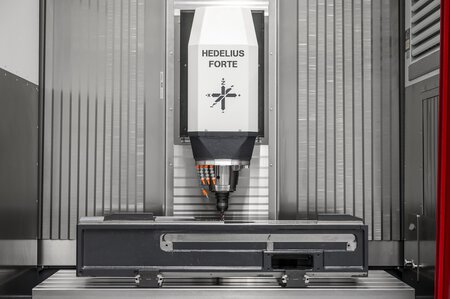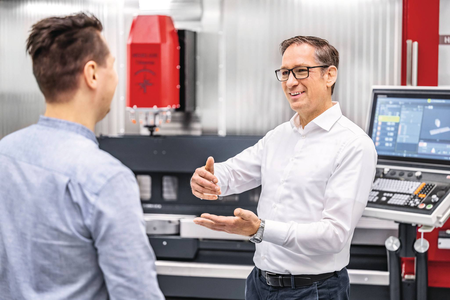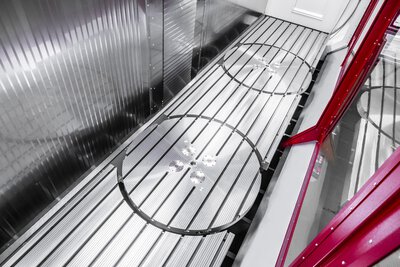21 November 2024
Small batches, big potential
How to make flexibility even
more productive.
In manufacturing companies that mainly produce small batch sizes, every minute of spindle time counts - or so the theory goes. In practice, however, the proportion of productive spindle time compared to working time is often less than 40 per cent. The search for tools, clamping devices and information, as well as set-up, tie up valuable resources and leave many operating companies far behind their potential. There are many ways to sustainably close flexibility - and thus performance - in production. But every manufacturing company is different. The trick is therefore to find your very own recipe for success.
HEDELIUS Maschinenfabrik
At HEDELIUS Maschinenfabrik GmbH in Meppen, Germany, they are very familiar with these kinds of challenges. The established manufacturer of CNC machining solutions is committed to increasing efficiency and flexibility in single parts and small series production in machine and tool manufacturing and contract manufacturing. In recent years, the company has taken productive parts manufacturing to a new level with its 5-axis machining centres from the ACURA series in combination with various automation solutions.
Significant increases in productivity
"Numerous customers report productivity increases of 50% and more thanks to the use of multi-pallet magazines in conjunction with large tool changers and the precise 5-axis technology of our compact ACURA series," says Dennis Hempelmann, Managing Director of HEDELIUS Maschinenfabrik GmbH. "But supplier companies in particular are always asking us to have larger single parts, panels or welded assemblies produced by skilled workers in the day shift so that they can then quickly switch back to an automated operation."
A travelling column machining centre with a swivelling main spindle is always a good choice for machining larger components. "Our TILTENTA series has been very popular for years," continues Dennis Hempelmann. It is particularly valued for its great flexibility, reliability and cutting performance.
Flexibility thanks to universal machine
The swivelling spindle machining centres in the TILTENTA series cover a wide range of production scenarios and therefore enable consistently high capacity utilisation. Both 5-axis machining of complex components and vertical machining of long parts are possible. With X travel paths of up to 6,200 mm, Y travel paths of up to 1,100 mm, collision area diameters of up to 1,450 mm and robust heavy-duty rotary tables, large, heavy workpieces weighing up to 2,200 kg can be machined with precision. The machines also offer the option of performing 5-axis machining in oscillation mode thanks to a work area partition.
"Flexibility is the be-all and end-all for us, and HEDELIUS machines embody this one hundred per cent," says Guido Piras, praising the engineering spirit of the Meppen-based company. He is the founder and managing director of Piras Metalltechnik GmbH & Co KG from Weißenstadt in the Fichtelgebirge, which manufactures individual and series parts, sometimes in unusual shapes and in a wide variety of dimensions and batch sizes. The modern machine park includes three machining centres from HEDELIUS, including a TILTENTA 9-3600 with a 180-fold STANDBY MAGAZIN. Highly complex components that can be manufactured on the TILTENTA 9-3600 to a reliably high quality are always in demand, especially in special machine construction. The option of precise front side processing of long parts also pays off time and time again. Guido Piras attests to the exemplary customer-orientation of the machine manufacturer from Lower Saxony: "You can tell that they really put a lot of thought into the design of the TILTENTA."

Piras and his employees swear by the high reliability of HEDELIUS machining centres. The picture shows (from left): Stefan Lautenbacher, Dominik Schöffel (both CNC specialists) and Guido Piras (managing director).

The 180-fold STANDBY MAGAZIN fascinated Piras right from the start and brings the operation enormous time and cost savings.
Intelligent automation concept
The new, automated TILTENTA 7-2000 NEO is the answer to the desire of small and medium-sized manufacturing companies for even more flexibility and productivity. With a 2,000 mm X travel path, the infinitely variable swivelling main spindle and the integrated 5-axis rotary table for workpieces up to 800 kg in weight and 1,050 mm in diameter, the TILTENTA 7-2000 NEO is an uncompromising universal machining centre that machines grey cast iron or tool steel just as reliably and precisely as aluminium. The multi-pallet magazine from the tried-and-tested MARATHON series from HEDELIUS provides a leap in productivity: the MARATHON SR415. The magazine has 15 pallet locations for components up to 700 mm in diameter and 500 mm clamping height. The storage/retrieval station can be rotated so that clamping towers or clamping pyramids, for example, can also be ergonomically tooling. Finished workpieces are unclamped and new ones are clamped in parallel to production. The workpieces are processed automatically one after the other, without manual intervention and without delays.
A decisive feature for achieving full flexibility with maximum productivity is the positioning of the pallet magazine on the side of the machine. The MARATHON loads the TILTENTA 7 fully automatically from the left-hand side of the machine. This means that the work area remains accessible for manual loading of components from the front and for crane loading from above. In other words, the machine can easily switch from processing larger single parts or welded assemblies by skilled workers in the day shift to fully automatic operation, for example to produce small and medium-sized series in the previously unused night and weekend shifts. And vice versa.

The TILTENTA 7-2000 NEO is an uncompromising universal machining centre that machines grey cast iron or tool steel just as reliably and precisely as aluminium. The multi-pallet magazine from the proven MARATHON series from HEDELIUS ensures a leap in productivity: the MARATHON SR415.

The storage/retrieval station can be rotated so that, for example, clamping towers or clamping pyramids can be ergonomically tooling. Finished workpieces are unclamped and new ones clamped at the same time.
Automation made easy
On the TILTENTA 7, the 700 mm rotary table is located on the left work area. "Unlike other solutions on the market, you can move the spindle completely over the rotary table without having to rotate it," explains Dennis Hempelmann. "This simplifies programming and workpiece infeed while increasing surface quality and accuracy."
Thanks to the zero point clamping system integrated into the machine table, the automation table can be removed in just a few simple handles - and the work area is then available for processing long workpieces or panels. The integrated rotary table is also equipped with T-slots for universal clamping. If shafts or tubes need to be machined, the machining centre can also be equipped with a vertical NC rotary table and a tailstock on the right-hand side of the machine.
Incidentally, the MARATHON SR415 is not the only automation system that can be connected to the TILTENTA 7-2000 NEO. HEDELIUS also offers the machine with an open interface for connecting automation systems from other manufacturers such as Indunorm or BMO - be it for pallet loading, workpiece loading or for combined loading of workpieces and pallets.
The more tools, the more flexible
If you work flexibly and have to machine many different parts, materials and batch sizes, you cannot do without a large tool magazine. The TILTENTA 7 has 45 tool slots as standard. Optionally, an STANDBY MAGAZIN can be integrated to open up an additional 309 pockets - which is generally a sensible option in the interests of maximising flexibility in an automated system. A cone cleaning station integrated as standard ensures that the tools are automatically cleaned and oiled. With over 300 tools on one machine, tooling times are almost completely eliminated. The STANDBY MAGAZIN requires little space, which is in accordance with the overall HEDELIUS concept of compact design and maximising output and flexibility in the smallest possible space.
Unlocking untapped potential
The combination of a stable travelling column machine with large travel paths and a large contact surface, the high clamping weights on the fixed and rotary table, the swivelling area of the spindle, a large tool magazine and automatic loading from the side enable enormous flexibility in production. A wide variety of customer orders can be processed much faster and more precisely, tooling times and set-up costs can be significantly reduced and previously unused time during night and weekend shifts can be utilised productively.
Source: mav 06-2024

Automation with TILTENTA
Automated long-bed milling machines with swivelling spindle.
TILTENTA machining centres offer unique universality in combined 5-axis and long part machining and are ideal for single parts and small series production. With additional automation solutions, our customers can maximise the productivity of their systems - for example through automatic operation in an additional shift or at weekends. In this way, the machine is utilised more efficiently and the available space is optimally utilised.
More news.

HEDELIUS managing director Dennis Hempelmann presents the outstanding advantages of the FORTE 65 and FORTE 85 machining centres. Thanks to the Operator's platform design, you benefit from maximum dynamics, optimised chip fall and maximum ergonomics. With spacious tool magazines, innovative zero-point clamping technology and intelligent automation solutions, you can sustainably increase your productivity. Experience precision and efficiency at a new level!

How is HEDELIUS meeting the current challenges in European machine tool manufacturing? What role does automation play in this - and what can the industry expect in the future? In this interview, Dennis Hempelmann provides insights into the strategic direction, new machine concepts and the importance of innovation in turbulent times.

Our latest innovation in the video: The TILTENTA 7 NEO, automated with the MARATHON SR415! Experience how our managing director Dennis Hempelmann presents the advantages of this 5-axis universal machining centre with multi-pallet magazine. See for yourself how unutilised potential can be tapped and production processes opened up to a new level of efficiency.












































































































































